No Experience Necessary
This shop assembled standard machine tools and components into a process for flexible production of a series of complex hydraulic cylinder components - all machined from solid, all accurate in some dimensions to +/-0.025 mm - in quantities that can exceed 3,000 per day, using only two operators per shift to shepherd this production from bar stock to shipping container.
First off, let me say that this is not a complete blueprint for reproducing the Youngers & Sons process. The contract machine shop, located in Viola, Kansas, asked that a few of its trade secrets remain exactly that. So suffice it to say this much about the process as a whole: No one turnkeyed this job, and no supplier custom-designed any hardware, including the tooling. Instead, Youngers & Sons assembled standard machine tools and components into a process for flexible production of a series of complex hydraulic cylinder components—all machined from solid, all accurate in some dimensions to ±0.025 mm—in quantities that can exceed 3,000 per day, using only two operators per shift to shepherd this production from bar stock to shipping container.
That last part is key. Youngers & Sons faces a critical manufacturing labor shortage in its part of the country. Among the company's 95 employees are just about all the available machinists the company is going to find, and the shop needs every hour of their time just to fill its more typical job shop workload of smaller-batch parts. When the cylinder components job came, the shop faced a more difficult task than just to devise a process that could run with a minimal staff. It had to devise a process that could run precisely and consistently with a minimal staff, every member of which had little or no background in machining.
Youngers & Sons did find capable employees to fill its four shifts with this process, and one of these men had run a lathe before.
As for the rest, they came from various occupations—construction and farming among them—but not machining.
Some Basics
The job: Youngers & Sons took on production of a series of hydraulic piston and gland parts, four families each, with multiple designs per family, machined in 1141 and 1215 steel. The pistons range in diameter from 2.25 to 5.75 inches, the glands from 3.0 to 6.5 inches. Critical tolerances include ±0.025 mm on ODs and on bore concentricity, and ±0.050 mm on the diameters of inner and outer grooves on the gland parts. Though the production mix varies according to a schedule that is generally known a few weeks in advance, batches are shipped on a daily basis.
The customer: Case Corporation, the maker of agriculture and construction equipment. Case is perhaps Youngers & Sons' most loyal customer. "Letting them down just wasn't an option," says vice president Neil Youngers (who, along with brother Wayne, is one of the "Sons" now running the business their father founded). Case was willing to offer a three-year contract, which let the shop invest both capital and intellect into developing an effective process for these parts. Neil stepped back from all of his other management responsibilities, and devoted over nine months to devising, implementing, and ramping up the piston and gland process.
The hardware currently at work in Mr. Youngers' process includes:
- Seven Okuma CNC lathes that feature opposing twin spindles and a live tool drive for milling and drilling,
- Gantry loaders from Wes-Tech Automation Systems, which deliver cut bar stock to each lathe and remove finished parts,
- Six (soon to be seven) bandsaws from HEM Inc., featuring automatic bar feed, and the precision to cut the shop's raw stock to a tolerance of ±0.5 mm on lengths, and
- Two Brown & Sharpe PC-controlled CMMs.
The "soon-to-be" number reflects the shop's ongoing expansion from an original three lathes to seven, in part to service an additional customer which has ordered parts similar to Case's. When this expansion is complete, the shop will expand to three operators per shift.
The challenge: Tools wear, machine positioning changes in subtle ways, and dozens of other variables in the process can drift sufficiently to break a ±0.025 mm tolerance. So how can the shop keep machining such precise parts around the clock, scrapping no more than a tiny percentage of them, using operators who may never have touched a machine tool or a micrometer before?
An important part of the solution, says Neil Youngers, is to reduce every operator responsibility in the process to straightforward, repeatable tasks—however numerous these tasks might be. The goal is to make the operator's role specific enough that he can know precisely what steps each of his responsibilities requires, and how often the process requires each responsibility to be carried out. Achieve this, he says, and machining skills can be replaced with more general time management skills, which diligent workers from various backgrounds may possess.
Achieving this was not easy. To design a process that could run smoothly without the oversight of a skilled machinist, Mr. Youngers frequently had to innovate. A striking example is his system for tightly controlling dimensional variations in the process. This system, which involves nothing more than clever use of CMM inspection and CNC offsets, delivers the secondary benefit of eliminating the need for an additional step for traditional quality assurance. Youngers & Sons' bid on the Case job did not have to include a separate price for this service. The only tradeoff is this: In the Youngers & Sons process, CMM inspection is essential.
"Another shop might keep producing if their CMM went down, and just do without their ability to check the parts, but we couldn't do that," Mr. Youngers says. "If we lost both our CMMs, we would be down until we could get one of them repaired."
How The Loop Is Closed
The system for dimensional control works like this: Machining offsets get changed whether they need it or not, and CMM inspection drives this updating.
The process dictates that operators inspect finished workpieces off of each lathe at regular and frequent intervals. The interval itself differs for different part numbers, but at the very least, parts are inspected several times per shift. Coordinate measuring machines are preprogrammed and located on the shop floor, so this inspection is only a matter of walking the part to the CMM, calling up the automatic inspection routine for that part number, and watching to see that the PC display indicates the part has passed. Even though the part passes, however, there is still work to do.
The principal function of this inspection is process control. Accordingly, the CMM program compares measured dimensions to ideal values at the center of the tolerance band. Wherever there is a discrepancy, this means that an aspect of the process is beginning to drift, so one or more machining offsets have to be changed to keep process accuracy on target. The operators make these changes. The process demands such precision that operators are fine-tuning at least some offsets nearly every time they inspect a part.
Production managers in the audience may have cringed upon reading this. Even in a process with experienced machinists at the helm, inviting operators to alter offsets regularly could easily lead to inconsistency and error. So how does this shop make it work, using operators with little machining background?
The key is that updating offsets is one more procedure which Youngers & Sons (in this case, with the help of the CMM supplier) has streamlined. In this process, the CMM software does not output geometric measurements, because a new operator may not know what feature a measurement relates to, let alone what correction to the process will answer a measurement that is trending out of spec.
Instead, the CMM software has been configured to output revised offset values, computed based on the inspection data. From the CMM's PC, the operator gets a printout listing offset numbers alongside the values to which those offsets should be changed for that particular lathe. This reduces the ongoing correction of these offsets to a straightforward exercise in data entry.
"You won't find any Vernier-style manual gages in this part of the shop," says Mr. Youngers. "The only gaging we need are our CMMs and a thread gage."
The system is not perfect; it does leave room for data entry errors. Indeed, a miskeyed offset is the biggest reason for scrapped parts in this process. A better solution would be for the CMM's control to communicate offset changes directly to the lathe's control, and in the future, direct networking like this may be an option for mid-sized shops like this. In the meantime, however, Youngers & Sons is doing very well with having operators close the loop by walking printouts back to the machine. And Mr. Youngers continues to look for ways that will reduce the incidence of error by reducing the number of offsets that have to be entered by hand.
His biggest single victory at this data entry reduction came when he successfully appended the CNC part programs to update tool wear offsets automatically. Prior to this improvement, accounting for tool wear was the most common reason why offsets had to be changed. But then the shop was given an order for a continuous run of 2500 pieces of a single part. This gave Mr. Youngers an opportunity to track the wear on all of the tools used for this part, and model the effect of wear on tool length offsets. He discovered from this that the rate at which tool length changes as a result of wear could be modeled linearly, without the part breaking spec. So now, he has the program subtract 1 micron from each tool's length after each given interval of parts has been machined—with the interval specific to the wear rate of that tool.
Automatically updating all tool length offsets in this way has not only reduced the opportunities for data entry error, but it has also made the process more accurate in one other way, Mr. Youngers says. The cycle is now adjusted for wear in real time, instead of being compensated only after the wear has occurred and the part has been machined.
The Process
Youngers & Sons' process is outlined in the sidebar starting on page 62. The process begins with bar stock (typically a 12-hour supply in front of each saw) and ends with finished parts being placed into shipping containers waiting just downstream from each lathe. Hourly production rate ranges from about ten parts for the largest gland model to 35 parts for the smallest piston. Shipments go to the customer daily, so the only inventory of finished parts the shop carries is overage. This inventory occupies no more than 50 square feet of floorspace in the shop.
Most of the steps in the process occur simultaneously. The process is so efficient that each of the CNCs is in program—that is, either the lathe is cutting or the loader is in motion—an average of 22 hours per day, six days per week.
Mr. Youngers knows this because the screen showing the percentage of in-program time is one he consults frequently on each CNC. The operators monitor the uptime, too. They compete to see who can keep productive time highest. Mr. Youngers says, "If ever I see the time dip below 21 hours, I start asking questions to see if something's broken down in our process."
The narrow product mix for these machines makes this productivity possible. Youngers & Sons could never achieve such uptime on machines in other parts of the shop which are devoted to widely varying, more traditional job shop work.
Even so, the small and reliable range of parts is only an enabler. Getting to 22 hours is the result of a two-part strategy designed to keep these machines running.
One part is the clearly defined procedures. Ideally, none of the operator's time is lost to judgment calls or indecision.
But the other part is hardware. Before the procedures could amount to anything, the process had to be equipped with the tools to make the uptime possible. For Neil Youngers, this translated into several decisions when he went shopping for equipment:
- He decided that lathes had to feature both secondary spindle and a live tool drive, so the entire machining process could be performed in one cycle. This not only minimizes staging and setup time, but it also ensures a part more likely to meet spec. Any mid-process handling would introduce opportunities for error.
- Every lathe gets its own bandsaw to cut stock. In general, this results in far too much saw capacity for the needs of just these lathes, but Mr. Youngers says this is just fine. Each lathe, including gantry loader, costs over 14 times the price of one of the precision saws. Therefore, "I can live with myself if a saw is all I see sitting idle," he says.
- Tooling and accessories were chosen for their potential to minimize changeover time. The process uses quick-change chucks, and modular, quick-change lathe tooling is used wherever possible.
Decisions like these put the potential for productivity in place. All that remained from there was to devise the procedures by which the operator could unlock that productivity. Making the operator's tasks straightforward was not enough. They also had to be predictable.
"Focus, Focus"
Tool change, for example, follows a strict 12-hour schedule. Every 12 hours, almost every tool in a lathe's turret is changed.
In some cases this means tools are changed before they are fully worn. In others, speeds and feeds are reduced or increased by slight amounts so tool life will come in right at 12 hours (or sometimes 24). This may lead to increased expense or a slightly longer machining cycle, but Youngers & Sons believes the payoff from a clean 12-hour system leads to productivity gains which more than offset these costs.
The payoff is that the operator never has to think about whether or not a tool needs to be changed. Tool change times for the various machines are staggered but carefully scheduled. When the time is right, the operator knows to change all of the tools but the long-life ones, in one sweep that takes about 10 minutes total. Thus, 10 minutes out of every 12 hours constitute the only loss that can be attributed to changing tools. And because the operator does not need to make a decision, there is no room to decide wrong. No parts are ever scrapped because a tool was allowed to run too long, and no time is ever wasted because the operator made a judgment call to change a given tool prematurely.
In other words, changing tools becomes a task that can be performed by rote, and therefore performed quickly. Changeover of the lathe to a different part number is similarly straightforward; the operator follows a checklist which also takes about 10 minutes to complete. The same is true of staging parts (one only places the slugs on the pads) as well as process control (one only takes the part to the CMM, and changes the offsets as directed). In short, each individual task has been made simple.
But does this make the entire process simple? Could anyone serve as an operator in this process?
No.
In fact, quite the opposite is true. Each discrete task may have been simplified, but managing all of the tasks sufficiently to keep numerous machines running 22 hours per day is a complex job requiring strategy and intelligence. This offers a clue to the kind of skills Youngers & Sons values for personnel running this process, versus the skills the shop has traditionally valued in more established areas of the shop. It may also offer a clue as to what the skilled machine operator of the future—at least in terms of a low-mix process—may be like. Consider:
Historically, a machinist was the process. Even in high-volume production, the person at the machine pulled the levers to make the cuts, and likely inspected the parts himself. And in many CNC processes today, a model similar to this is still at work.
But this is not the model for the operator in the Youngers & Sons process. Here, the operator does not have to know about the machining requirements of the parts themselves, or the optimal sequence for performing this machining. That thinking has already been done. Instead, the knowledge for which the operator is valued is his knowledge of the system, and his skill at coordinating the requirements of all of the machines to squeeze every bit of productive time and consistency out of the process.
"We've learned that the emphasis has to be focus, focus," Neil Youngers says.
The process is complex enough that when the operator tries to adjust it at his level, he affects it in unintended ways. This was demonstrated when the process was still new, during an incident in which an operator attempted to correct the process for an error that was scrapping parts. The correction he implemented, though well-reasoned and reasonable, proved to be the wrong one. He made an adjustment at the lathe for an error that was in fact the result of a mistake in setting up the saw. Thus, not only did he turn his attention away from keeping all of the other machines producing, but he also confounded the problem.
"He lost his focus, and we all learned from that," says Mr. Youngers. "What he should have done is call me. I know now that, even if the call comes at 2 a.m., it's better for me to attend to the problem than to let an operator lose sight of the crucial tasks he has to perform."
The New Tool Kit
The process is so sensitive that even much smaller human variations can throw it off. The ramp-up period for the process consisted largely of locating and removing sources of these variations. For example, four inserted drills broke one month, immediately following a month in which none of the drills had broken. What changed?
After watching the process long enough, Mr. Youngers at last tracked down the problem: Operators were using their own personal wrenches to tighten the inserts, and these wrenches showed various states of wear. Mr. Youngers responded by standardizing this tool. All of the existing wrenches were replaced with new ones, and this particular type of wrench is now treated as a wear item, to be replaced on a regular basis.
"Machining can be a predictable process, but standardization like this is what it takes," Mr. Youngers says.
An attentive operator can handle numerous tasks, but the more complex the process is, the more these tasks have to be governed by clear strategies.
"When we have a seven-machine process all the way on-line, coordinating tool change, staging, maintenance, inspection and changeover, the rest will become even more difficult. For example, I plan to ask each operator, How will you inspect all those parts? You need a system; you can't just do it randomly."
This more complex process will cause the operator's tool kit to change in more ways than just the switch to standard wrenches. To help operators allocate their time, the shop will encourage them to use a planning board with tasks represented as moveable magnets, allowing each operator to map out and visualize his activities in advance, before the shift begins.
But the more significant changes are in the mental tool kit. Youngers & Sons originally devised this process to run effectively with operators having no training as CNC machinists. Now, the shop is considering an investment in training, but machining skills are not what the company hopes to impart.
"Would we invest in teaching these guys how to program a tool path, or how to read a micrometer? No; there's no need," Mr. Youngers says.
"But would we invest in sending them to time management classes? We are seriously considering this, yes."
Read Next
The Cut Scene: The Finer Details of Large-Format Machining
Small details and features can have an outsized impact on large parts, such as Barbco’s collapsible utility drill head.
Read More3 Mistakes That Cause CNC Programs to Fail
Despite enhancements to manufacturing technology, there are still issues today that can cause programs to fail. These failures can cause lost time, scrapped parts, damaged machines and even injured operators.
Read More
.jpg;width=70;height=70;mode=crop)



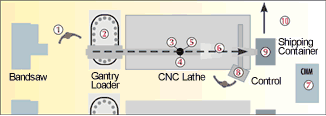

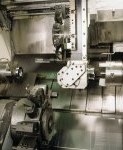

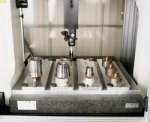

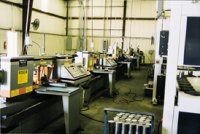
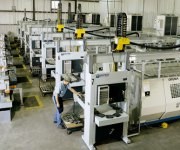






.png;maxWidth=300;quality=90)












